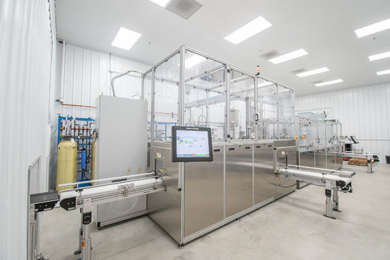Cleaning & Passivation

Cadence uses the latest precision cleaning and passivation technology, including:
- Ultrasonically assist washing in sequential steps
- Fully programmable cycles optimized for part size and shape
- Micro-filtration and magnetic separation for removal of all fines.
- In-line citric acid passivation to ASTM specifications
We offer:
- Nitric Acid Passivation
- Citric Acid Passivation
- Electropolishing
Cadence currently has any of these three methods available for passivation, including Nitric Passivation (to ASTM A967-05 Nitric 2), Citric acid passivation, and Electropolishing. Any of these methods can be an acceptable alternative so we offer all three for maximum process flexibility for our customers.
Stainless Steel Passivation - In order to better understand the options for passivating stainless steel, it is critical to first understand what the term “passivation” means. [stainless steel passivation]
According to ASTM A 380 – 96, the term passivation is commonly applied to several distinctly different operations or processes relating to stainless steels. Common meanings include the following:
Passivation is the process by which a stainless steel will spontaneously form a chemically inactive surface when exposed to air or other oxygen-containing environments.Passivation is removal of exogenous iron or iron compounds from the surface of a stainless steel by means of a chemical dissolution, most typically by a treatment with an acid solution that will remove the surface contamination but will not significantly affect the stainless steel itself.Passivation is the chemical treatment of a stainless steel with a mild oxidant, such as a nitric acid solution, for the purpose of enhancing the spontaneous formation of the protective passive film.
There are three (3) main methods for stainless steel passivation that have been used in the medical device and diagnostics markets for years:
- Nitric Acid Passivation: Nitric acid passivation is one of the most well known and long standing passivation methods. The major advantage of using Nitric acid for passivating stainless steel is the fact that Nitric acid not only removes free iron from the surface, but it also contributes as surface oxidizer by contributing to form an extra oxide layer that is often 10-20 angstroms thick. Another advantage is that surface analytical methods also reveal that the Chromium oxide layer can be up to 25% thicker when using Nitric acid passivation. There are major issues related to using Nitric acid as a passivation chemistry due to safety, handling and environmental concerns.
- Citric Acid Passivation: Recent developments in green technologies led to a very common chemistry that is now utilized for passivation. Citric acid is very good at removing free iron from stainless steel surfaces. It is getting much wider acceptance due to the improved environmental and safety effects as compared to Nitric acid. Citric acid is not as good of an oxidizer as Nitric, but this disadvantage is easily overcome with the addition of oxidizing rinses to its post-treatment steps.
- Electropolishing: Electropolishing is the best passivation method in terms of removing free iron from stainless steel surfaces. It also forms an oxide layer that can be up to 20 angstroms thick to yield a higher chromium oxide/iron oxide ratio. It is a commonly accepted passivation method listed in the infamous ASTM A967 passivation standard. Electropolishing yields passive properties AND it has the additional potential benefits of removing burrs or scratches from the surface and providing a more glossy appearance.
Cadence currently has any of these three methods available for passivation, including Nitric Passivation (to ASTM A967-05 Nitric 2), Citric acid passivation, and Electropolishing. Any of these methods can be an acceptable alternative so we offer all three for maximum process flexibility for our customers.
